Local Co-location Pattern Detection: A Summary of Results
Authors Yan Li, Shashi Shekhar
-
Part of:
Volume:
10th International Conference on Geographic Information Science (GIScience 2018)
Part of: Series: Leibniz International Proceedings in Informatics (LIPIcs)
Part of: Conference: International Conference on Geographic Information Science (GIScience) - License:
 Creative Commons Attribution 3.0 Unported license
Creative Commons Attribution 3.0 Unported license
- Publication Date: 2018-08-02
File

PDF
LIPIcs.GISCIENCE.2018.10.pdf
- Filesize: 1.25 MB
- 15 pages
Document Identifiers
Subject Classification
ACM Subject Classification
- Information systems → Geographic information systems
- Information systems → Data mining
Keywords
- Co-location pattern
- Participation index
- Spatial heterogeneity
Metrics
- Access Statistics
-
Total Accesses (updated on a weekly basis)
0Document
0Metadata
Abstract
Given a set of spatial objects of different features (e.g., mall, hospital) and a spatial relation (e.g., geographic proximity), the problem of local co-location pattern detection (LCPD) pairs co-location patterns and localities such that the co-location patterns tend to exist inside the paired localities. A co-location pattern is a set of spatial features, the objects of which are often related to each other. Local co-location patterns are common in many fields, such as public security, and public health. For example, assault crimes and drunk driving events co-locate near bars. The problem is computationally challenging because of the exponential number of potential co-location patterns and candidate localities. The related work applies data-unaware or clustering heuristics to partition the study area, which results in incomplete enumeration of possible localities. In this study, we formally defined the LCPD problem where the candidate locality was defined using minimum orthogonal bounding rectangles (MOBRs). Then, we proposed a Quadruplet & Grid Filter-Refine (QGFR) algorithm that leveraged an MOBR enumeration lemma, and a novel upper bound on the participation index to efficiently prune the search space. The experimental evaluation showed that the QGFR algorithm reduced the computation cost substantially. One case study using the North American Atlas-Hydrography and U.S. Major City Datasets was conducted to discover local co-location patterns which would be missed if the entire dataset was analyzed or methods proposed by the related work were applied.
Cite As Get BibTex
Yan Li and Shashi Shekhar. Local Co-location Pattern Detection: A Summary of Results. In 10th International Conference on Geographic Information Science (GIScience 2018). Leibniz International Proceedings in Informatics (LIPIcs), Volume 114, pp. 10:1-10:15, Schloss Dagstuhl – Leibniz-Zentrum für Informatik (2018)
https://doi.org/10.4230/LIPIcs.GISCIENCE.2018.10
BibTex
@InProceedings{li_et_al:LIPIcs.GISCIENCE.2018.10,
author = {Li, Yan and Shekhar, Shashi},
title = {{Local Co-location Pattern Detection: A Summary of Results}},
booktitle = {10th International Conference on Geographic Information Science (GIScience 2018)},
pages = {10:1--10:15},
series = {Leibniz International Proceedings in Informatics (LIPIcs)},
ISBN = {978-3-95977-083-5},
ISSN = {1868-8969},
year = {2018},
volume = {114},
editor = {Winter, Stephan and Griffin, Amy and Sester, Monika},
publisher = {Schloss Dagstuhl -- Leibniz-Zentrum f{\"u}r Informatik},
address = {Dagstuhl, Germany},
URL = {https://drops.dagstuhl.de/entities/document/10.4230/LIPIcs.GISCIENCE.2018.10},
URN = {urn:nbn:de:0030-drops-93387},
doi = {10.4230/LIPIcs.GISCIENCE.2018.10},
annote = {Keywords: Co-location pattern, Participation index, Spatial heterogeneity}
}
Author Details
References
- Adrian Baddeley. Spatial Point Processes and their Applications. In Stochastic Geometry, volume 1892 of Lecture Notes in Mathematics, pages 1-75. Springer, Berlin, Heidelberg, 2007. URL: http://dx.doi.org/10.1007/978-3-540-38175-4_1.
- S. Barua and J. Sander. Mining Statistically Significant Co-location and Segregation Patterns. IEEE Transactions on Knowledge and Data Engineering, 26(5):1185-1199, 2014. URL: http://dx.doi.org/10.1109/TKDE.2013.88.
- Mete Celik, James M. Kang, and Shashi Shekhar. Zonal co-location pattern discovery with dynamic parameters. In Data Mining, 2007. ICDM 2007. Seventh IEEE International Conference on, pages 433-438. IEEE, 2007. URL: http://ieeexplore.ieee.org/abstract/document/4470269/.
- Chicago Police Department. Crimes - 2001 to present, 2017. [Online; accessed 30-September-2017]. URL: https://data.cityofchicago.org/Public-Safety/Crimes-2001-to-present/ijzp-q8t2.
-
Sung Nok Chiu, Dietrich Stoyan, Wilfrid S. Kendall, and Joseph Mecke. Stochastic Geometry and Its Applications. John Wiley &Sons, 2013.

- Min Deng, Jiannan Cai, Qiliang Liu, Zhanjun He, and Jianbo Tang. Multi-level method for discovery of regional co-location patterns. International Journal of Geographical Information Science, 31(9):1846-1870, 2017. URL: http://dx.doi.org/10.1080/13658816.2017.1334890.
- Christoph F. Eick, Rachana Parmar, Wei Ding, Tomasz F. Stepinski, and Jean-Philippe Nicot. Finding Regional Co-location Patterns for Sets of Continuous Variables in Spatial Datasets. In Proceedings of the 16th ACM SIGSPATIAL International Conference on Advances in Geographic Information Systems, GIS '08, pages 30:1-30:10, New York, NY, USA, 2008. ACM. URL: http://dx.doi.org/10.1145/1463434.1463472.
- Guilbert Gates, Jack Ewing, Karl Russell, and Derek Watkins. How Volkswagen’s ‘Defeat Devices’ Worked. The New York Times, 2015. URL: https://www.nytimes.com/interactive/2015/business/international/vw-diesel-emissions-scandal-explained.html.
- Yan Huang, Shashi Shekhar, and Hui Xiong. Discovering colocation patterns from spatial data sets: a general approach. IEEE Transactions on Knowledge and Data Engineering, 16(12):1472-1485, 2004. URL: http://ieeexplore.ieee.org/xpls/abs_all.jsp?arnumber=1350759.
- Pradeep Mohan, Shashi Shekhar, James A. Shine, James P. Rogers, Zhe Jiang, and Nicole Wayant. A Neighborhood Graph Based Approach to Regional Co-location Pattern Discovery: A Summary of Results. In Proceedings of the 19th ACM SIGSPATIAL International Conference on Advances in Geographic Information Systems, GIS '11, pages 122-132, New York, NY, USA, 2011. ACM. URL: http://dx.doi.org/10.1145/2093973.2093991.
- USGS. North america rivers and lakes, 2018. [Online; accessed 13-February-2018]. URL: https://www.sciencebase.gov/catalog/item/4fb55df0e4b04cb937751e02.
- Song Wang, Yan Huang, and Xiaoyang Sean Wang. Regional Co-locations of Arbitrary Shapes. In Advances in Spatial and Temporal Databases, pages 19-37. Springer Berlin Heidelberg, 2013. URL: http://dx.doi.org/10.1007/978-3-642-40235-7_2.
- Jordan Wood. Minimum Bounding Rectangle. In Shashi Shekhar, Hui Xiong, and Xun Zhou, editors, Encyclopedia of GIS, pages 1232-1233. Springer International Publishing, 2 edition, 2017. URL: http://dx.doi.org/10.1007/978-3-319-17885-1_783.
- Jin Soung Yoo and S. Shekhar. A Joinless Approach for Mining Spatial Colocation Patterns. IEEE Transactions on Knowledge and Data Engineering, 18(10):1323-1337, oct 2006. URL: http://dx.doi.org/10.1109/TKDE.2006.150.
